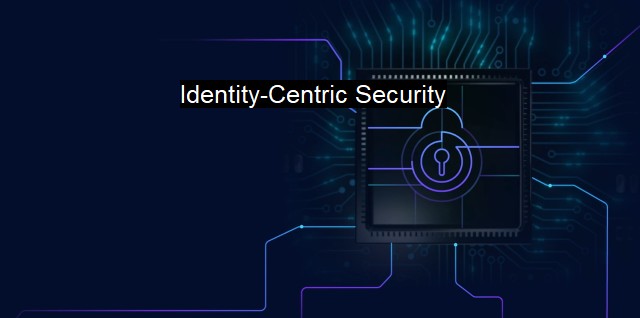What is Identity-Centric Security?
Identity-Centric Security: Developing Customized Cybersecurity Solutions to Combat Evolving Threats
"Identity-Centric Security" , also known as identity-focused security, is a strategic approach that emphasizes the identification and authorization of individuals accessing data and services within an enterprise's network. This security strategy is developed on the foundation that everyone and everything has an identity, which can be authenticated and authorized prior to accessing any enterprise resources. Identity-centric security practices are particularly useful in today’s cybersecurity landscape where traditional perimeter-based protocols are proving to be insufficient for the complex security threats.In the contemporary digital age, businesses embrace the constant flux of data, systems, and users, meaning that the potential points of security vulnerability have increased multifold. Fundamental shifts in the operation of enterprises, including Bring Your Own Device (BYOD) policies, off-site employees, cloud-based tools, and diverse online services have blurred network boundaries. The data is no longer confined within enterprise walls, it resides in various public and private clouds, numerous databases, devices, and applications, making it susceptible to breaches and leaks.
In this setting, identity-centric security focusing on ‘who’ rather than ‘where’ become crucial. Simply said, it’s no longer adequate to protect just the access points, it is equally vital to secure access to the data and services themselves. Identity-centric security modules identify each access requestor’s path, their data usage, the accessed data types, and other similar features that endeavor to mitigate unauthorized access risks. These security processes work by utilizing sophisticated algorithms and techniques that link the individual by their behavior and pattern, in addition to identifying credentials like their username, password, and the like.
With the rise of hackers and other online security threats, enterprises have realized that access control to their sensitive data should not be limited to mere usernames and passwords. Biometrics, tokens, and behavior are all employed as a means to reinforce identity security. For instance, if an employee is trying to gain access to high-value data at abnormal hours, these features can flag this behavior as suspicious for investigation. This is the essence of identity-centric security.
Identity-centric security also lends significance to robust yet adaptable security defenses. When a new risk or threat is perceived, adjustments can be made per user or per risk. Consequently, it allows intelligent strategic adjustments, that is, it grants permissions to trusted identities and inhibits suspicious ones. They also provide insights into each entity's behavior and relationships which empowers security teams' decision-making.
Applying an identity-focused approach requires a fundamental shift in how every organization operates – it necessitates that every business transforms from a system-centric to an identity-centric modus operandi. It’s like redesigning the core fabric of an organization’s cybersecurity game plan.
It's worth noting that to ensure successful implementation of identity-centric security measures, enterprises need to apply the principle of least privilege (PoLP) which constitutes granting only essential access permissions required for a user’s job role. It is essentially preventing excess privileges leading to potentially disastrous security incidents. training programs should be engineered to apprise every network user about various threat profiles, safe practices, and the urgency of promptly reporting anomalies.
To sum up, identity-centric security integrates a wide-ranging and deep security framework into enterprises' existing infrastructures. It represents the future of cybersecurity where enterprises anticipate seamless security coverage integrated across the complete global digital landscape. The efficacy of antivirus and traditional cybersecurity measures is drastically enhanced with the inclusion of identity-centric security strategies and is pivotal in protecting against modern and sophisticated cybersecurity threats.

Identity-Centric Security FAQs
What is identity-centric security?
Identity-centric security is an approach to cybersecurity that prioritizes user identity as a central element of the security model. It focuses on protecting an organization's assets from unauthorized access or misuse by implementing identity-based access controls, authentication protocols, and other mechanisms that identify and verify the user's identity.How does identity-centric security differ from traditional security approaches?
Traditional security approaches tend to focus on securing the perimeter of the network or system, using firewalls, intrusion detection systems, and other tools. Identity-centric security, on the other hand, assumes that the perimeter has already been breached and focuses on securing the data and resources within. It shifts the emphasis to controlling access to sensitive information based on the user's identity, rather than trying to keep intruders out.What are the benefits of identity-centric security?
Identity-centric security provides several benefits, including more granular control over who has access to what data or resources, improved visibility into user activities and behavior, better compliance management, and greater resilience against insider threats. It also enables organizations to better manage the risks associated with remote workers, contractors, and partners who require access to company systems and data.How can organizations implement identity-centric security?
To implement identity-centric security, an organization needs to establish a strong identity and access management (IAM) strategy that incorporates authentication, authorization, and auditing capabilities. This can involve implementing technologies such as multi-factor authentication, role-based access control, and user behavior analytics. It also requires a cultural shift within the organization to prioritize security awareness and education, so that employees understand the importance of safeguarding their identities and protecting the company's assets.| | A | | | B | | | C | | | D | | | E | | | F | | | G | | | H | | | I | | | J | | | K | | | L | | | M | |
| | N | | | O | | | P | | | Q | | | R | | | S | | | T | | | U | | | V | | | W | | | X | | | Y | | | Z | |
| | 1 | | | 2 | | | 3 | | | 4 | | | 7 | | | 8 | | |||||||